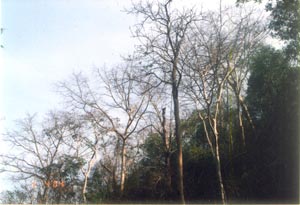Deciduous forests have predominantly broad-leafed trees. Temperate deciduous forests occur in areas of moderate temperature and rainfall with cold winters. Species belonging to these forests drop leaves in autumn. The deciduous forests in tropical areas shed leaves only by December (in the Northern Hemisphere) when water becomes scarce.

Tropical Monsoon Deciduous Forests in
India:
The tropical monsoon deciduous forests are found in areas
receiving annual rainfall of 100 to 200 cms in India, with a
distinct dry and rainy seasons and a small range of temperature.
They occur on the wetter western side of the Deccan
Plateau, the north-eastern part of the Deccan Plateau and the
lower slopes of the Himalayas, on the Siwalik Hills from Jammu
in the west to West Bengal in the east.
They cover parts of Chhattisgarh, Orissa, Bihar, Jharkand,
Andhra Pradesh, Karnataka, Kerala and Tamil Nadu.
The principal trees of these forests are teak, sal, sandalwood,
mahua, khair, mango, jackfruit, wattle and bamboo, semal,
sisasm, myrobalan, arjun and the banyan tree. They shed their
leaves for six to eight weeks during the dry season, usually
from March to May, to prevent the loss of moisture through
evapo-transpiration.
